
Champmol
Encyclopedia
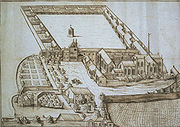
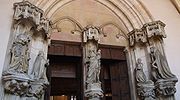
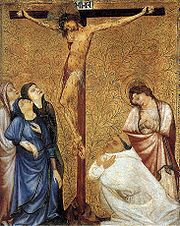
Carthusian
The Carthusian Order, also called the Order of St. Bruno, is a Roman Catholic religious order of enclosed monastics. The order was founded by Saint Bruno of Cologne in 1084 and includes both monks and nuns...
monastery
Monastery
Monastery denotes the building, or complex of buildings, that houses a room reserved for prayer as well as the domestic quarters and workplace of monastics, whether monks or nuns, and whether living in community or alone .Monasteries may vary greatly in size – a small dwelling accommodating only...
on the outskirts of Dijon
Dijon
Dijon is a city in eastern France, the capital of the Côte-d'Or département and of the Burgundy region.Dijon is the historical capital of the region of Burgundy. Population : 151,576 within the city limits; 250,516 for the greater Dijon area....
, which is now in France, but in the 15th century was the capital of the Duchy of Burgundy
Duchy of Burgundy
The Duchy of Burgundy , was heir to an ancient and prestigious reputation and a large division of the lands of the Second Kingdom of Burgundy and in its own right was one of the geographically larger ducal territories in the emergence of Early Modern Europe from Medieval Europe.Even in that...
. The monastery was founded in 1383 by Duke Philip the Bold
Philip the Bold
Philip the Bold , also Philip II, Duke of Burgundy , was the fourth and youngest son of King John II of France and his wife, Bonne of Luxembourg. By his marriage to Margaret III, Countess of Flanders, he also became Count Philip II of Flanders, Count Philip IV of Artois and Count-Palatine Philip IV...
to provide a dynastic burial place for the Valois Dukes of Burgundy, and operated until it was dissolved in 1791, during the French Revolution
French Revolution
The French Revolution , sometimes distinguished as the 'Great French Revolution' , was a period of radical social and political upheaval in France and Europe. The absolute monarchy that had ruled France for centuries collapsed in three years...
. Called "the grandest project in a reign renowned for extravagance", it was lavishly enriched with works of art, and the dispersed remnants of its collection remain key to the understanding of the art of the period.
Founding
Purchase of the land and quarrying of materials began in 1377, but construction did not begin until 1383, under the architect Druet de Dammartin from Paris, who had previously designed the Duke's chateau at SluisSluis
Sluis is the name of both a municipality and a town located in the west of Zeelandic Flanders, in the south-western part of the Netherlands....
, and been an assistant in work at the Louvre
Louvre
The Musée du Louvre – in English, the Louvre Museum or simply the Louvre – is one of the world's largest museums, the most visited art museum in the world and a historic monument. A central landmark of Paris, it is located on the Right Bank of the Seine in the 1st arrondissement...
. According to James Snyder
James Snyder
James Snyder may refer to:*James S. Snyder, Anne and Jerome Fisher Director, The Israel Museum, Jerusalem*Jimmy Snyder , American racecar driver*Jim Snyder , Major League Baseball player and coach...
his work at Champmol was "a somewhat conservative modification of the Late Gothic buildings of Paris". A committee of councillors from Dijon supervised the construction for the Duke, who was often elsewhere. By 1388 the church was consecrated, and most construction probably completed. The monastery was built for twenty-four choir monk
Choir monk
In Roman Catholicism the term "Choir Monk" is used to distinguish monks who may become priests from the lay brothers who are occupied mainly with secular affairs....
s, instead of the usual twelve in a Carthusian house, and two more were endowed to celebrate the birth in 1433 of Charles the Bold. These lived semi-hermitic lives in their individual small houses when not in the chapel. There would also have been non-ordained monks, servants, novices, and other workers.
When founded, Champmol was "two arrow shots" outside the city gates, but is now inside the modern city boundaries. At this time the city had about 10,000 inhabitants and was the largest in Burgundy
Duchy of Burgundy
The Duchy of Burgundy , was heir to an ancient and prestigious reputation and a large division of the lands of the Second Kingdom of Burgundy and in its own right was one of the geographically larger ducal territories in the emergence of Early Modern Europe from Medieval Europe.Even in that...
proper, though smaller than the cities of the territories in the Netherlands recently inherited by the Duke through his wife. But Burgundy was held more securely than the often turbulent cities in the north, and represented the senior title of the dynasty. Over sixty members of the Capetian
Capetian dynasty
The Capetian dynasty , also known as the House of France, is the largest and oldest European royal house, consisting of the descendants of King Hugh Capet of France in the male line. Hugh Capet himself was a cognatic descendant of the Carolingians and the Merovingians, earlier rulers of France...
House of Burgundy
House of Burgundy
The House of Burgundy was a cadet branch of the Capetian dynasty, descending from Robert I, Duke of Burgundy, a younger son of Robert II of France....
, whom the Valois had succeeded in 1361, only two decades earlier, had been buried at Cîteaux Abbey
Cîteaux Abbey
Cîteaux Abbey is a Roman Catholic abbey located in Saint-Nicolas-lès-Cîteaux, south of Dijon, France. Today it belongs to the Trappists, or Cistercians of the Strict Observance . The Cistercian order takes its name from this mother house of Cîteaux, earlier Cisteaux, near Nuits-Saint-Georges...
to the south of Dijon. Champmol was intended to rival Cîteaux, Saint-Denis
Saint-Denis
Saint-Denis is a commune in the northern suburbs of Paris, France. It is located from the centre of Paris. Saint-Denis is a sous-préfecture of the Seine-Saint-Denis département, being the seat of the Arrondissement of Saint-Denis....
, where the Kings of France were buried, and other dynastic burial places.
Somewhat in contradiction to the Carthusian mission of tranquil contemplation, visitors and pilgrims were encouraged, the expenses of hospitality recompensed by the Dukes. In 1418 Papal indulgence
Indulgence
In Catholic theology, an indulgence is the full or partial remission of temporal punishment due for sins which have already been forgiven. The indulgence is granted by the Catholic Church after the sinner has confessed and received absolution...
s were granted to those visiting the Well of Moses
Well of Moses
The Well of Moses is a monumental sculpture recognised as the masterpiece of the Dutch artist Claus Sluter . It was executed by Sluter and his workshop in 1395–1403 for the Carthusian monastery of Chartreuse de Champmol built as a burial site by the Burgundian Duke Philip the Bold just outside the...
, further encouraging pilgrims. The ducal family had a private oratory
Oratory
Oratory is a type of public speaking.Oratory may also refer to:* Oratory , a power metal band* Oratory , a place of worship* a religious order such as** Oratory of Saint Philip Neri ** Oratory of Jesus...
overlooking the church (now destroyed), though their visits were in fact rare. The ducal accounts, which have fortunately survived, show major commissions for paintings and other works to complete the monastery continuing until about 1415, and further works were added after that at a slower rate by the Dukes and other donors.
The accounts for Champmol have survived in sufficient detail that Martin Warnke synthesized from them a view of the emerging status of court artist
Court painter
A court painter was an artist who painted for the members of a royal or noble family, sometimes on a fixed salary and on an exclusive basis where the artist was not supposed to undertake other work. Especially in the late Middle Ages, they were often given the office of valet de chambre...
s, and "the autonomous consciousness of art and artists" that would distinguish the world of art in the Early modern period
Early modern period
In history, the early modern period of modern history follows the late Middle Ages. Although the chronological limits of the period are open to debate, the timeframe spans the period after the late portion of the Middle Ages through the beginning of the Age of Revolutions...
.
Tombs of the Dukes
The Valois dynasty of Burgundy had less than a century to run when the monastery was founded, and the number of tombs never approached that of their Capetian predecessors at Cîteaux - indeed there would hardly have been room in the choir of the church, where the monuments were. Only two monuments were ever erected, both in the same style with painted alabasterAlabaster
Alabaster is a name applied to varieties of two distinct minerals, when used as a material: gypsum and calcite . The former is the alabaster of the present day; generally, the latter is the alabaster of the ancients...
effigies with lions at their feet and angels with spread wings at their heads. Underneath the slab the effigies rested on, unpainted small (about 40 cm high) "pleurants" or mourners ("weepers" is the traditional English term) were set among Gothic tracery
Tracery
In architecture, Tracery is the stonework elements that support the glass in a Gothic window. The term probably derives from the 'tracing floors' on which the complex patterns of late Gothic windows were laid out.-Plate tracery:...
. These were described by Johan Huizinga
Johan Huizinga
Johan Huizinga , was a Dutch historian and one of the founders of modern cultural history.-Life:Born in Groningen as the son of Dirk Huizinga, a professor of physiology, and Jacoba Tonkens, who died two years after his birth, he started out as a student of Indo-Germanic languages, earning his...
in The Waning of the Middle Ages as "the most profound expression of mourning known in art, a funeral march in stone".
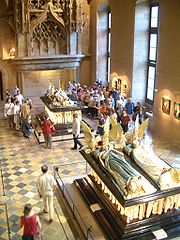
Margaret III, Countess of Flanders
Margaret of Dampierre was Countess of Flanders , Countess of Artois and Countess Palatine of Burgundy and twice Duchess consort of Burgundy...
the following year. She had decided to rest her remains with those of her parents in Lille
Lille
Lille is a city in northern France . It is the principal city of the Lille Métropole, the fourth-largest metropolitan area in the country behind those of Paris, Lyon and Marseille. Lille is situated on the Deûle River, near France's border with Belgium...
, and Philip had been planning a single monument for himself for over twenty years, having commissioned Jean de Marville in 1381. Work did not begin until 1384, and proceeded slowly, with Claus Sluter
Claus Sluter
Claus Sluter was a sculptor of Dutch origin. He was the most important northern European sculptor of his age and is considered a pioneer of the "northern realism" of the Early Netherlandish painting that came into full flower with the work of Jan van Eyck and others in the next generation.Sluter...
being put in charge in 1389. At the Duke's death in 1404, only two mourners and the framework were complete; John the Fearless gave Sluter four years to finish the job, but he died after two. His nephew and assistant, Claus de Werve took over and finished the sculptures in 1410. The effigies were painted by Malouel.
John expressed a wish for his own tomb, this time a double one with his Duchess Margaret of Bavaria
Margaret of Bavaria
Margaret of Bavaria, , was the fifth child of Albert, Duke of Bavaria-Straubing, Count of Hainault, Holland, and Zeeland and Lord of Friesia, and Margaret of Brieg. She was the regent of the Burgundian Low countries during the absence of her spouse in 1404–1419 and the regent in French Burgundy...
, to resemble that of his father, but nothing was done, even after his death in 1419, until 1435, and in 1439 de Werve died without having managed to find suitable alabaster
Alabaster
Alabaster is a name applied to varieties of two distinct minerals, when used as a material: gypsum and calcite . The former is the alabaster of the present day; generally, the latter is the alabaster of the ancients...
. In 1443 a Spaniard, Jean de La Huerta, was contracted, and sent drawings for the effigies. He completed most elements, but not the effigies, before leaving Dijon in 1456. Yet another master was brought in, and the monument finally installed in 1470, by which time Philip the Good was himself dead. He seems to have made no provision for a monument for himself, and had initially been buried in Bruges
Bruges
Bruges is the capital and largest city of the province of West Flanders in the Flemish Region of Belgium. It is located in the northwest of the country....
, where he died. His son Charles the Bold had the remains brought back to Champmol after some years, but no monument was ever planned. Charles himself was relocated from Nancy to Bruges by his great-grandson Charles V
Charles V, Holy Roman Emperor
Charles V was ruler of the Holy Roman Empire from 1519 and, as Charles I, of the Spanish Empire from 1516 until his voluntary retirement and abdication in favor of his younger brother Ferdinand I and his son Philip II in 1556.As...
in 1558.
The second tomb repeats the design of the first, but with their execution spanning almost a century, stylistic differences can be seen, although some of the "pleurants" of the second tomb copy those of the first exactly. It is recorded that Philip the Good had a portrait of himself placed in the choir, where there were already those of the previous two Dukes. None of these are believed to have survived in the original, but surviving portraits may be copies of them.
After the Revolution, and the sale of the monastery, the tombs were carefully moved to Dijon Cathedral in 1792, as their historic importance was recognised. But in the following year the cathedral was converted into a Temple of Reason
Temple of Reason
The Temple of Reason was, during the French Revolution, a temple for a new belief system created to replace Christianity: the Cult of Reason, which were based on the ideals of atheism and humanocentrism...
and the effigies were vandalised, so that what are now seen are reconstructions. Many elements, including ten "pleurants", were removed by genteel looters.
Works of art from Champmol
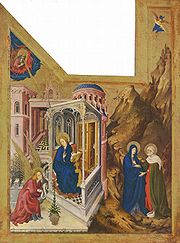

Illuminated manuscript
An illuminated manuscript is a manuscript in which the text is supplemented by the addition of decoration, such as decorated initials, borders and miniature illustrations...
s, of French and Burgundian art of the period. Without the works that remained at Champmol until the 18th century, Claus Sluter
Claus Sluter
Claus Sluter was a sculptor of Dutch origin. He was the most important northern European sculptor of his age and is considered a pioneer of the "northern realism" of the Early Netherlandish painting that came into full flower with the work of Jan van Eyck and others in the next generation.Sluter...
, Jacques de Baerze
Jacques de Baerze
Jacques de Baerze was a Flemish sculptor in wood, two of whose major carved altarpieces survive in Dijon, now in France, then the capital of the Duchy of Burgundy....
, Melchior Broederlam
Melchior Broederlam
Melchior Broederlam was one of the earliest Early Netherlandish painters to whom surviving works can be confidently attributed. He worked mostly for Philip the Bold, Duke of Burgundy, and is documented from 1381 to 1409...
, Henri Bellechose
Henri Bellechose
Henri Bellechose was a painter from the South Netherlands. He was one of the most significant artists at the beginning of panel painting in Northern Europe, and among the earliest artists of Early Netherlandish painting.-Biography:Bellechose was an artist who came from the South Netherlands to...
, Jean Malouel
Jean Malouel
Jean Malouel, or Jan Maelwael in his native Dutch, was a Netherlandish artist, sometimes classified as French, who was the court painter of Philip the Bold, Duke of Burgundy and his successor John the Fearless, working in the International Gothic style.-Documented life:He was presumably born in...
, and Jean de Beaumetz
Jean de Beaumetz
Jean de Beaumetz is recorded to have been "painter and valet" to Philip the Hardy, for whom he painted numerous works, and decorated, among other chapels, that of the Castle of Argilli, in Burgundy. Some of his mural paintings are still preserved at château de Germolles. Jean de Beaumetz was...
would remain only names known from documentary records.
Still at Champmol
There are very important sculptures by Claus SluterClaus Sluter
Claus Sluter was a sculptor of Dutch origin. He was the most important northern European sculptor of his age and is considered a pioneer of the "northern realism" of the Early Netherlandish painting that came into full flower with the work of Jan van Eyck and others in the next generation.Sluter...
and his workshop on the church portal, including kneeling figures of Philip and his Duchess. The lower parts of the Well of Moses
Well of Moses
The Well of Moses is a monumental sculpture recognised as the masterpiece of the Dutch artist Claus Sluter . It was executed by Sluter and his workshop in 1395–1403 for the Carthusian monastery of Chartreuse de Champmol built as a burial site by the Burgundian Duke Philip the Bold just outside the...
(Puits de Moise) survive, including six life-size figures of the Old Testament
Old Testament
The Old Testament, of which Christians hold different views, is a Christian term for the religious writings of ancient Israel held sacred and inspired by Christians which overlaps with the 24-book canon of the Masoretic Text of Judaism...
prophets who foretold the Messiah
Messiah
A messiah is a redeemer figure expected or foretold in one form or another by a religion. Slightly more widely, a messiah is any redeemer figure. Messianic beliefs or theories generally relate to eschatological improvement of the state of humanity or the world, in other words the World to...
, most of the rest having been destroyed, apparently more by weathering than the Revolution.
In Dijon museums
Most items are in the Musée des Beaux-Arts, including its site in the former palace of the Dukes. The fragments from the Well of Moses and other similar pieces are in the Archaeological Museum. The following are only the main works in Dijon:- Two painted and gilded carved wood retableRetableA retable is a framed altarpiece, raised slightly above the back of the altar or communion table, on which are placed the cross, ceremonial candlesticks and other ornaments....
s, that are almost the only remaining works by the Flemish sculptor Jacques de BaerzeJacques de BaerzeJacques de Baerze was a Flemish sculptor in wood, two of whose major carved altarpieces survive in Dijon, now in France, then the capital of the Duchy of Burgundy....
, and also the only complete Netherlandish carved altarpieces before the late 15th century. The outer panels of the larger are the only surviving paintings by Melchior BroederlamMelchior BroederlamMelchior Broederlam was one of the earliest Early Netherlandish painters to whom surviving works can be confidently attributed. He worked mostly for Philip the Bold, Duke of Burgundy, and is documented from 1381 to 1409...
, and highly important works for tracing the development of Early Netherlandish paintingEarly Netherlandish paintingEarly Netherlandish painting refers to the work of artists active in the Low Countries during the 15th- and early 16th-century Northern renaissance, especially in the flourishing Burgundian cities of Bruges and Ghent...
. Broederlam also painted and gilded the carvings by de Baerze.
- The tombs (in fact always cenotaphCenotaphA cenotaph is an "empty tomb" or a monument erected in honour of a person or group of people whose remains are elsewhere. It can also be the initial tomb for a person who has since been interred elsewhere. The word derives from the Greek κενοτάφιον = kenotaphion...
s) of the Dukes of Burgundy; the museum has the tombs of Philip the Bold and his son John the Fearless with his wife Margaret of BavariaMargaret of BavariaMargaret of Bavaria, , was the fifth child of Albert, Duke of Bavaria-Straubing, Count of Hainault, Holland, and Zeeland and Lord of Friesia, and Margaret of Brieg. She was the regent of the Burgundian Low countries during the absence of her spouse in 1404–1419 and the regent in French Burgundy...
. The effigies are 19th century reconstructions, from old drawings and prints, of the originals which were destroyed in the Revolution. About ten of the "pleurants" are also copies of originals liberated or lost.
- The funerary crown of Philip the Bold, in brassBrassBrass is an alloy of copper and zinc; the proportions of zinc and copper can be varied to create a range of brasses with varying properties.In comparison, bronze is principally an alloy of copper and tin...
and glass.
- The head and torso of the crucified Christ from the Well of Moses.
- The Retable of Saint George, an early 15th century painted altarpiece, probably donated by one of the monks, whose donor portraitDonor portraitA donor portrait or votive portrait is a portrait in a larger painting or other work showing the person who commissioned and paid for the image, or a member of his, or her, family...
appears at the foot of the crucified Christ.
- One of the crucifixions from the two hermitages added in 1433.
- Two altarpieces by Charles-André van LooCharles-André van LooCarle or Charles-André van Loo was a French subject painter, and a younger brother of Jean-Baptiste van Loo and grandson of Jacob van Loo. He was the most famous member of a successful dynasty of painters of Dutch origin...
, which replaced older works (one the Retable of Saint George) in 1741.
Elsewhere

- LouvreLouvreThe Musée du Louvre – in English, the Louvre Museum or simply the Louvre – is one of the world's largest museums, the most visited art museum in the world and a historic monument. A central landmark of Paris, it is located on the Right Bank of the Seine in the 1st arrondissement...
, the Martyrdom of Saint Denis by Henri Bellechose, the tondoTondo (art)A tondo is a Renaissance term for a circular work of art, either a painting or a sculpture. The word derives from the Italian rotondo, "round." The term is usually not used in English for small round paintings, but only those over about 60 cm in diameter, thus excluding many round portrait...
of the PietàPietàThe Pietà is a subject in Christian art depicting the Virgin Mary cradling the dead body of Jesus, most often found in sculpture. As such, it is a particular form of the Lamentation of Christ, a scene from the Passion of Christ found in cycles of the Life of Christ...
by Jean Malouel, and one of 24 paintings of the crucifixion for the monks' hermitages by Jean de Beaumetz, all of which are the best known works of each artist. - Washington, National Gallery of Art, the Annunciation by Jan van EyckAnnunciation (van Eyck, Washington)The Annunciation is an oil painting by the Early Netherlandish master Jan van Eyck, from around 1434-1436. It is in the National Gallery of Art, in Washington D.C. It was originally on panel but has been transferred to canvas. It is thought that it was the left wing of a triptych; there has...
; the two other panels of the triptychTriptychA triptych , from tri-= "three" + ptysso= "to fold") is a work of art which is divided into three sections, or three carved panels which are hinged together and can be folded shut or displayed open. It is therefore a type of polyptych, the term for all multi-panel works...
recorded at Champmol in 1791 have been lost. - Gemäldegalerie, BerlinGemäldegalerie, BerlinThe Gemäldegalerie is an art museum in Berlin, Germany. It holds one of the world's leading collections of European art from the 13th to the 18th centuries. It is located on Kulturforum west of Potsdamer Platz. Its collection includes masterpieces from such artists as Albrecht Dürer, Lucas...
, a large Madonna and Child, only rediscovered in 1960 and now on loan to the Gemäldegalerie, is attributed to Jean Malouel It is believed the Berlin picture was one wing of a diptychDiptychA diptych di "two" + ptychē "fold") is any object with two flat plates attached at a hinge. Devices of this form were quite popular in the ancient world, wax tablets being coated with wax on inner faces, for recording notes and for measuring time and direction.In Late Antiquity, ivory diptychs with...
for Champmol, opposite a portrait of John the Fearless. - Cleveland Museum of ArtCleveland Museum of ArtThe Cleveland Museum of Art is an art museum situated in the Wade Park District, in the University Circle neighborhood on Cleveland's east side. Internationally renowned for its substantial holdings of Asian and Egyptian art, the museum houses a diverse permanent collection of more than 43,000...
, the only other one of the 24 paintings by Jean de Beaumetz to survive, and four "pleurant" figures from Philip's tomb. - Baltimore, Walters Art MuseumWalters Art MuseumThe Walters Art Museum, located in Baltimore, Maryland's Mount Vernon neighborhood, is a public art museum founded in 1934. The museum's collection was amassed substantially by two men, William Thompson Walters , who began serious collecting when he moved to Paris at the outbreak of the American...
, half of the "Antwerp-Baltimore Polyptych" c. 1400. - Antwerp, the other three scenes of the "Antwerp-Baltimore Polyptych"
- Musée de Cluny, Paris, two bone and ivoryIvoryIvory is a term for dentine, which constitutes the bulk of the teeth and tusks of animals, when used as a material for art or manufacturing. Ivory has been important since ancient times for making a range of items, from ivory carvings to false teeth, fans, dominoes, joint tubes, piano keys and...
relief triptychs by the leading Italian Embriachi workshop, donated by Duke Philip in 1393. - Chicago (Art Institute of ChicagoArt Institute of ChicagoThe School of the Art Institute of Chicago is one of America's largest accredited independent schools of art and design, located in the Loop in Chicago, Illinois. It is associated with the museum of the same name, and "The Art Institute of Chicago" or "Chicago Art Institute" often refers to either...
), the figure from a gilded and painted wood crucifixCrucifixA crucifix is an independent image of Jesus on the cross with a representation of Jesus' body, referred to in English as the corpus , as distinct from a cross with no body....
by de Baerze and Broederlam.
Later history
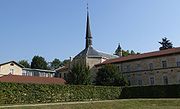
French Wars of Religion
The French Wars of Religion is the name given to a period of civil infighting and military operations, primarily fought between French Catholics and Protestants . The conflict involved the factional disputes between the aristocratic houses of France, such as the House of Bourbon and House of Guise...
, but essentially the monastery remained in its 15th century state until it was decided to update it in the 1770s. The altarpieces of Saints Denis and George had been replaced by new paintings by Charles-André van Loo
Charles-André van Loo
Carle or Charles-André van Loo was a French subject painter, and a younger brother of Jean-Baptiste van Loo and grandson of Jacob van Loo. He was the most famous member of a successful dynasty of painters of Dutch origin...
in 1741; both the new paintings are now in the Dijon museum. Remodelling in the 1770s involved the destruction of some medieval parts, but greater destruction followed the French Revolution. The monastery was suppressed in 1791, and on May 4, five days after the monks departed, the buildings and land were bought by Emmanuel Crétet (1747–1808), later to be Minister of the Interior under Napoleon with the title Comte de Champmol. He destroyed large parts of the buildings and the church. In 1833 the estate was bought by the local département as a mental asylum, and many new buildings erected.
Today the buildings house a psychiatric hospital, and "aller à la chartreuse" is a local phrase for developing a mental disorder. The Sluter sculptures can be seen by visitors, and many of the contents are in the Dijon museum, with the tombs and carved retables housed in the former Palace of the Dukes.
Further reading
- Bibliography from the Cleveland exhibition
- Fliegel, Stephen N., et al. . Art from the Court of Burgundy: Patronage of Philip the Bold and John the Fearless, 1364–1419. Exhibition catalogue. Cleveland: Cleveland Museum of Art, 2004.
- Lindquist, Sherry C.M. Agency, Visuality and Society at the Chartreuse de Champmol, 2008, Ashgate, ISBN 978-0-7546-6046-0
- Monget, Cyprien. La chartreuse de Dijon, 3 vols, Montreuil-sur-Mer, Tournai, 1898–1905

